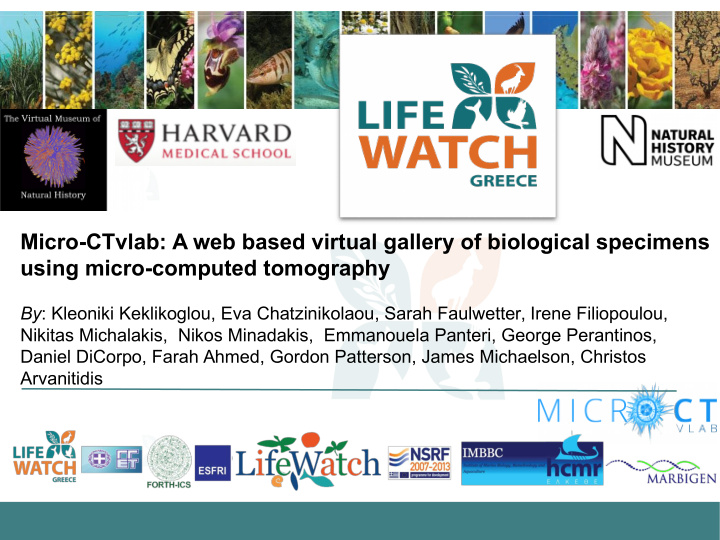



Micro-CTvlab: A web based virtual gallery of biological specimens using micro-computed tomography By : Kleoniki Keklikoglou, Eva Chatzinikolaou, Sarah Faulwetter, Irene Filiopoulou, Nikitas Michalakis, Nikos Minadakis, Emmanouela Panteri, George Perantinos, Daniel DiCorpo, Farah Ahmed, Gordon Patterson, James Michaelson, Christos Arvanitidis
What is micro-CT? •Non destructive three-dimensional imaging technique similar to computer tomography used in hospitals, just on a much smaller scale •Samples of a few millimeters up to a size of a mouse, and structures in the range of a few microns (<0,8μm/pixel) can be seen in the images LifeWatch Greece
What is micro-CT? LifeWatch Greece
Scanning procedure LifeWatch Greece
Image acquisition LifeWatch Greece
Visualisation Exterior parts Interior parts LifeWatch Greece
The idea Source: http://www.naturkundemuseum-berlin.de/typo3temp/pics/d09e9f46e0.jpg Type material Cybertype Godfray, HCJ (2007) Linnaeus in the information age. Nature 446: 259–260 LifeWatch Greece
A cybertype should... • provide morphological and anatomical information of the same accuracy and reliability as the physical type material LifeWatch Greece
A cybertype should... • be linked to the original type material, which can be consulted if in doubt Bruker Micro-CT User Meeting 2015 LifeWatch Greece
A cybertype should... • be created without affecting the morphological, anatomical and molecular identity of the physical specimen Bruker Micro-CT User Meeting 2015 LifeWatch Greece
A cybertype should... • be retrievable … but how ?? LifeWatch Greece
Through the way of cybertype creation... The development of a virtual micro-CT virtual laboratory (Micro-CT vLab) aims at making the micro- CT data exploration of natural history specimens freely available over the Internet This vLab has been created in the context of the LifeWatch Research Infrastructure (ESFRI) LifeWatch Greece
LifeWatch - the concept of ESFRIs LifeWatch Greece
LifeWatch - challenges (Questions) LifeWatch Greece
LifeWatch - challenges (Ifrastructure) VRE: Virtual Research Environment - e-Services (electronic services) - vLabs (virtual laboratories) - Computational capacity unlimited space - Transparency in scientific research practice LifeWatch Greece
LifeWatchGreece Research (e-)Infrastructure LifeWatch Greece
But how about if we start the real integration in biology? LifeWatch Greece
But how about if we start the real integration in biology? Example from IMGs miro_CT scan phenomics phenome LifeWatch Greece
LifeWatch Greece
Micro-CT virtual galleries - 650 scans have been created and for the initiation of this web service only 17 of them were uploaded - The uploaded datasets belong to several marine species and they are fully annotated with metadata 7 micro-CT datasets can be downloaded from the Dryad Digital Repository which is a repository system for several datatypes The remaining datasets can be shared through personal communication as the storage is still under construction LifeWatch Greece
Accessed through LifeWatchGreece Portal portal.lifewatchgreece.eu LifeWatch Greece
Home Page Scans are presented as a preview of images with the title of the dataset LifeWatch Greece
Search tool LifeWatch Greece
The micro-CT dataset Short description of the dataset Gallery of 3D images Related datasets LifeWatch Greece
3D visualization LifeWatch Greece
3D visualization LifeWatch Greece
Video LifeWatch Greece
Metadata LifeWatch Greece
Mobile App LifeWatch Greece
Conclusions A cybertype should… • provide morphological and anatomical information of the same accuracy and reliability as the physical type material Technological progress is still required Combination with other digitization methods LifeWatch Greece
Conclusions A cybertype should… • be linked to the original type material, which can be consulted if in doubt Standards for proper curation and documentation of 3D-types should be developed (by museums and IT community) LifeWatch Greece
Conclusions A cybertype should… • be created without affecting the morphological, anatomical and molecular identity of the physical specimen • Experiments (staining – de-staining, genetic etc) concerning a variety of organisms is still required LifeWatch Greece
Conclusions A cybertype should… • be retrievable is a first step However... Installation of a storage area network (SAN) Standards for proper curation and documentation of 3D- types should be developed LifeWatch Greece
Conclusions In the long term these developments will transform taxonomic research into a true cyber-discipline More and more morphological and anatomical data will become available in an electronic, shareable format This will speed up systematic research, as morphological, high- resolution information can be accessed at the click of a mouse, and analyzed in completely new ways by 3D pattern recognition algorithms Steering comparative morphology into a new direction and shifting from the current use of phenetics to that of phenomics LifeWatch Greece
Conclusions Where are we now? Developing a draft WP for a proposal on Museums and collections (BioUnify; COST instrument (EU)) The overall objective of such a WP would be to: “ bring all the scientific community interested in the micro-CT scanning technology for natural sciences and biodiversity together in order to discuss and decide on issues that are required to achieve a consensus on sharing and distributing data and metadata, and the development of the respective infrastructure at the international scale ”. Therefore, the specific objectives of such a WP might be: Creation of standards of the data files needed to be stored; Creation of protocols and standards of meta-data; Storage space solutions; Development of strategy on the terms of use for data and metadata; 3D pattern recognition technology solutions; Design and roadmap for the development of an international distributed infrastructure. LifeWatch Greece
https://www.youtube.com/watch?v=RcAjPIZVla0 LifeWatch Greece
Thank you https://www.youtube.com/watch?v=RcAjPIZVla0 LifeWatch Greece
LifeWatch Greece
Recommend
More recommend